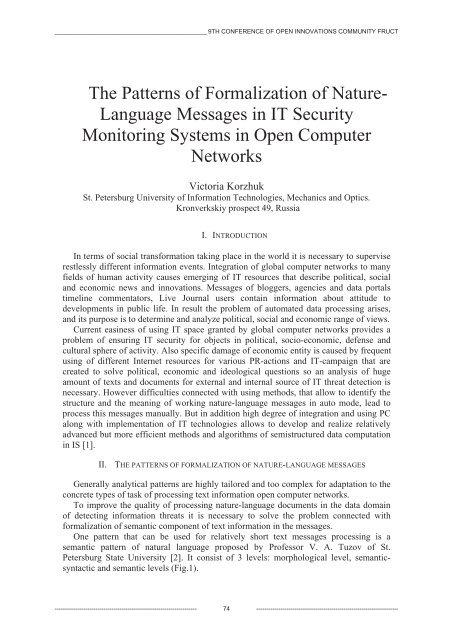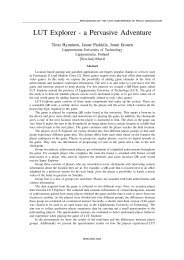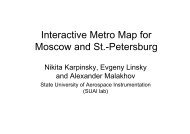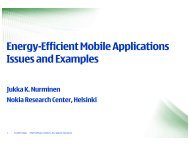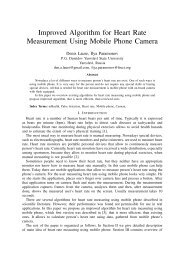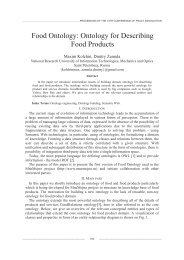6th Seminar of Finnish-Russian University Cooperation - FRUCT
6th Seminar of Finnish-Russian University Cooperation - FRUCT
6th Seminar of Finnish-Russian University Cooperation - FRUCT
Create successful ePaper yourself
Turn your PDF publications into a flip-book with our unique Google optimized e-Paper software.
_____________________________________________ 9TH CONFERENCE OF OPEN INNOVATIONS COMMUNITY <strong>FRUCT</strong><br />
The Patterns <strong>of</strong> Formalization <strong>of</strong> Nature-<br />
Language Messages in IT Security<br />
Monitoring Systems in Open Computer<br />
Networks<br />
Victoria Korzhuk<br />
St. Petersburg <strong>University</strong> <strong>of</strong> Information Technologies, Mechanics and Optics.<br />
Kronverkskiy prospect 49, Russia<br />
I. INTRODUCTION<br />
In terms <strong>of</strong> social transformation taking place in the world it is necessary to supervise<br />
restlessly different information events. Integration <strong>of</strong> global computer networks to many<br />
fields <strong>of</strong> human activity causes emerging <strong>of</strong> IT resources that describe political, social<br />
and economic news and innovations. Messages <strong>of</strong> bloggers, agencies and data portals<br />
timeline commentators, Live Journal users contain information about attitude to<br />
developments in public life. In result the problem <strong>of</strong> automated data processing arises,<br />
and its purpose is to determine and analyze political, social and economic range <strong>of</strong> views.<br />
Current easiness <strong>of</strong> using IT space granted by global computer networks provides a<br />
problem <strong>of</strong> ensuring IT security for objects in political, socio-economic, defense and<br />
cultural sphere <strong>of</strong> activity. Also specific damage <strong>of</strong> economic entity is caused by frequent<br />
using <strong>of</strong> different Internet resources for various PR-actions and IT-campaign that are<br />
created to solve political, economic and ideological questions so an analysis <strong>of</strong> huge<br />
amount <strong>of</strong> texts and documents for external and internal source <strong>of</strong> IT threat detection is<br />
necessary. However difficulties connected with using methods, that allow to identify the<br />
structure and the meaning <strong>of</strong> working nature-language messages in auto mode, lead to<br />
process this messages manually. But in addition high degree <strong>of</strong> integration and using PC<br />
along with implementation <strong>of</strong> IT technologies allows to develop and realize relatively<br />
advanced but more efficient methods and algorithms <strong>of</strong> semistructured data computation<br />
in IS [1].<br />
II. THE PATTERNS OF FORMALIZATION OF NATURE-LANGUAGE MESSAGES<br />
Generally analytical patterns are highly tailored and too complex for adaptation to the<br />
concrete types <strong>of</strong> task <strong>of</strong> processing text information open computer networks.<br />
To improve the quality <strong>of</strong> processing nature-language documents in the data domain<br />
<strong>of</strong> detecting information threats it is necessary to solve the problem connected with<br />
formalization <strong>of</strong> semantic component <strong>of</strong> text information in the messages.<br />
One pattern that can be used for relatively short text messages processing is a<br />
semantic pattern <strong>of</strong> natural language proposed by Pr<strong>of</strong>essor V. A. Tuzov <strong>of</strong> St.<br />
Petersburg State <strong>University</strong> [2]. It consist <strong>of</strong> 3 levels: morphological level, semanticsyntactic<br />
and semantic levels (Fig.1).<br />
---------------------------------------------------------------------- 74 ----------------------------------------------------------------------
_____________________________________________ 9TH CONFERENCE OF OPEN INNOVATIONS COMMUNITY <strong>FRUCT</strong><br />
M=, (1)<br />
where W – set <strong>of</strong> wordforms,<br />
Se – set <strong>of</strong> semantic templates,<br />
K – set <strong>of</strong> classes.<br />
The feature <strong>of</strong> Pr. Tuzov nature-language pattern is united semantic-syntactic level.<br />
On this basis every word has morphological and semantic-syntactic characteristics which<br />
are the foundation for semantic predicate.<br />
Morphological level<br />
Syntactic level<br />
Semantic level<br />
Fig.1. Semantic pattern <strong>of</strong> language by Pr. Tuzov<br />
Semantic predicate<br />
SemSint(A1~K1,…,An~Kn)<br />
Ai - morphological information<br />
Ki - a class <strong>of</strong> added word<br />
Adding system <strong>of</strong> functions for indication to the class hierarchy allows to translate<br />
constructions associated on the basis <strong>of</strong> rules in predicate to the semantic language<br />
This pattern allows eliminating ambiguity <strong>of</strong> construction and reduces amount <strong>of</strong><br />
noises in the document classification problem.<br />
General wordform description template in the Pr. Tuzov’s Dictionary is represented as<br />
G(Z1:!Nominative{K1}g, Z2:!Genitive{K2} g, Z3:!Dative{K3} g, Z4:!Absolutive{K4} g,<br />
Z5:!Instrumental{K5} g, Z6:!Prepositional{K6} g),<br />
where {K1}g... {K6}g is a set <strong>of</strong> classes corresponding to a given wordform.<br />
But Tuzov’s semantic dictionary and Svedova’s and Efremova’s dictionaries that<br />
are used for the same tasks and also dictionary database <strong>of</strong> AOT and RCO companies<br />
are very different in structure, number <strong>of</strong> classes and the number <strong>of</strong> its constituent words.<br />
In result these products need additional adaptation for concrete text analyzing task<br />
connected with clarification <strong>of</strong> content and form (ex. arborescent or linear form) <strong>of</strong><br />
wordform classificator.<br />
The Pr. Tuzov’s nature-language pattern suggests the possibility <strong>of</strong> analysis <strong>of</strong><br />
every sentence <strong>of</strong> nature (<strong>Russian</strong>) language. Development <strong>of</strong> the using semantic data<br />
base occurred through the automated processing <strong>of</strong> different texts including literary texts.<br />
Due to random order <strong>of</strong> the words (ex. adjective can be separated from its noun by tokens<br />
so it located in another part <strong>of</strong> the sentence) it is necessary to make an exhaustion <strong>of</strong> all<br />
arguments to calculate the possibility <strong>of</strong> forming links for building nature-language<br />
structure <strong>of</strong> construction. On the other hand despite the support and development <strong>of</strong> this<br />
model there are certain troubles with computation <strong>of</strong> the result <strong>of</strong> sentence analysis<br />
because <strong>of</strong> emerging ambiguous wordforms, that influence on the construction <strong>of</strong><br />
information objects. The high support cost are needed for using a pattern given here.<br />
Adapted pattern which is designed to find concrete thematic information has<br />
fewer defects [3,4]. Similarly to the Tuzov’s semantic pattern adapted pattern is divided<br />
into morphological, syntactic and semantic levels. Nevertheless semantic and syntactic<br />
---------------------------------------------------------------------- 75 ----------------------------------------------------------------------
_____________________________________________ 9TH CONFERENCE OF OPEN INNOVATIONS COMMUNITY <strong>FRUCT</strong><br />
levels are parted. Syntactic level contains information about links between words and<br />
semantic level defines the rules <strong>of</strong> the analysis, synthesis and processing <strong>of</strong> constructions.<br />
M= (2)<br />
where W – set <strong>of</strong> wordforms,<br />
Si – set <strong>of</strong> syntactic templates, Si Se ,<br />
Ks – set <strong>of</strong> classes, Ks K<br />
Morphological level<br />
Syntactic level<br />
Semantic level<br />
Semantic-grammatical type <strong>of</strong> prepositional-case form,<br />
Ki =17 + Semantic-grammatical type <strong>of</strong> certain parts<br />
<strong>of</strong> speech<br />
Fig.2. Adapted language pattern<br />
Syntactic predicate Sint(A1,…,An)<br />
Ai – morphological information +<br />
system <strong>of</strong> priorities for building<br />
Feature <strong>of</strong> this pattern is using <strong>of</strong> scalable predicates <strong>of</strong> wordform arguments<br />
information description <strong>of</strong> object-oriented dictionary data bases <strong>of</strong> natural language that<br />
allows to identify, to compare and to build control rules <strong>of</strong> processing at the level <strong>of</strong><br />
links.<br />
Scalable predicate is identical to semantic predicate <strong>of</strong> the previous model in<br />
composition. But here classes <strong>of</strong> identification sets which affect the type and semantic<br />
meaning <strong>of</strong> nature-language construction within the subject area are used instead <strong>of</strong><br />
semantic class. Let us descry the construction and the features <strong>of</strong> it.<br />
In our case analysis <strong>of</strong> stylistics in blog texts and time-lines <strong>of</strong> news agencies shows<br />
that long sentences are frequent in the works <strong>of</strong> <strong>Russian</strong> classics. Average length <strong>of</strong> such<br />
texts is about 10 words, and it is confirmed by statistic researches published on the<br />
dedicated to classical linguistics sites. Adjectives and qualifying nouns in the ablative<br />
and genitive, phrases which are identified with words “that”, “which”, “who” and some<br />
other and participles are not scattered on the message text but are close to the basic nouns<br />
that are forming construction. Assessment <strong>of</strong> the work <strong>of</strong> text information source <strong>of</strong> the<br />
Internet may be implemented through approaches based on the mistakes <strong>of</strong> the first and<br />
second kind. In this case dictionary databases adapt to the specific subject area.<br />
Limitations <strong>of</strong> subject area allow decreasing large number <strong>of</strong> ambiguous wordforms. Let<br />
us descry the simplified sentence convolution algorithm without focusing on the parts <strong>of</strong><br />
speech and sentence, as numerals, conjunctions, particles, participles, gerunds and<br />
subordinate clauses.<br />
Description <strong>of</strong> solutions for syntactic analyzer can be found at AOT company site<br />
(www.aot.ru). Principle <strong>of</strong> the algorithm is ordered sequential exhaustion method <strong>of</strong><br />
about 40 rules.<br />
But for text analysis in monitoring systems the most <strong>of</strong> the information is a noun. Its<br />
identification with followed accession <strong>of</strong> subordinate adjectives, adverbs, participles<br />
allows not spending resources on the calculation the type <strong>of</strong> formed constructions when<br />
---------------------------------------------------------------------- 76 ----------------------------------------------------------------------
_____________________________________________ 9TH CONFERENCE OF OPEN INNOVATIONS COMMUNITY <strong>FRUCT</strong><br />
the link forms. This algorithm uses the description <strong>of</strong> word-forms <strong>of</strong> parts <strong>of</strong> speech,<br />
based on a template containing syntactic information about potential links:<br />
G(Z1:!Nominative, Z2:!Genitiv, Z3:!Dative, Z4:!Absolutive, Z5:!Instrumental, Z6:<br />
Prepositional).<br />
Describing concrete wordform redundant links are removed. For example for the<br />
majority <strong>of</strong> the nouns syntactic pattern is<br />
G(Z1:!Genitive).<br />
Typical patterns <strong>of</strong> parts <strong>of</strong> speech and features <strong>of</strong> its using are show in [5]. The<br />
highest priority is given to the analysis <strong>of</strong> the possible formation <strong>of</strong> links between two<br />
nearest wordforms.<br />
In simple extended sentence the following parts <strong>of</strong> speech: verbs, nouns, adjectives,<br />
adverbs may be contained (or not contained). The figure3 shows a sequence <strong>of</strong> steps <strong>of</strong><br />
sentence convolution.<br />
Simplified algorithm consists <strong>of</strong> the following steps:<br />
1) Accession subordinate adjectives to nouns. Main information is taken from the<br />
morphological wordform descriptor. On the first viewing the proposals from left to right<br />
next in line adjectives and nouns that are consistent on cases, the gender and number, are<br />
searched. As an adjective may be the right from a noun, it requires a similar view from<br />
right to left, which makes an attempt to join the remaining adjectives were not included<br />
in the construction.<br />
Due to space limitations, we will not dwell on individual cases where adjectives do<br />
not sequence on morphological information with their nouns, for example:<br />
Tools and techniques - proven.<br />
Such situations have a finite amount, and they are amenable to a fairly rigorous<br />
description and formalization.<br />
2) Accession <strong>of</strong> prepositions to the nouns and adjectives structure. Feature <strong>of</strong> this step<br />
is that the preposition is always left from the noun construction. Main information for the<br />
implementation <strong>of</strong> the convolution is a syntactic preposition descriptor and<br />
morphological construction descriptor <strong>of</strong> the noun. The information about the preposition<br />
includes case and the using noun class.<br />
3) Accession noun constructions to other objects is based on analysis <strong>of</strong> syntactic<br />
descriptor <strong>of</strong> left part and morphological and syntactic descriptor <strong>of</strong> right part and it is<br />
performed from left to right. Regardless <strong>of</strong> the descriptions the nouns object in the<br />
genitive case are attached to structures, standing on the left.<br />
4) All completed constructions are substituted into the predicate <strong>of</strong> verb functions on<br />
the basis <strong>of</strong> their syntactic information.<br />
5) Adverbs and assembled constructions not included in the descriptor verbs are<br />
attributed to it with its own semantic and grammatical type.<br />
It should be noted that the <strong>Russian</strong> language is quite regular and exceptions to the rule<br />
amounts to not more than 10%.<br />
Participial constructions, adverbial participle constructions, subordinate clauses<br />
beginning with words “which”, composite constructions like “if ... then” and embedded<br />
sentences should be separated before analysis. are exposed to the convolution algorithm,<br />
and then received constructions attached to the main proposal. All these constructions are<br />
subjected to convolution algorithm, and then received constructions are attached to the<br />
unitary clause.<br />
---------------------------------------------------------------------- 77 ----------------------------------------------------------------------
_____________________________________________ 9TH CONFERENCE OF OPEN INNOVATIONS COMMUNITY <strong>FRUCT</strong><br />
Preposition<br />
+<br />
Noun Adjective<br />
Adjective<br />
Fig.3. Simplified sentence convolution algorithm<br />
Depending on the stylistic features <strong>of</strong> texts <strong>of</strong> the subject area and without<br />
grammatical errors parser produces 60% -80% <strong>of</strong> appropriate structures.<br />
Number <strong>of</strong> comparisons Number <strong>of</strong> wordforms<br />
Fig.4. The dependence <strong>of</strong> the number <strong>of</strong> checks on the number <strong>of</strong> links word forms<br />
+<br />
Noun (Adjective)<br />
Preposition and Noun (Adjective)<br />
Preposition and Noun (Adjective)<br />
Preposition and Noun (Adjective)<br />
Preposition and Noun (Adjective)<br />
+<br />
Noun<br />
Verb (Preposition and Noun (Adjective) i n)<br />
Adverb<br />
Adverb<br />
Pr. Tuzov’s<br />
pattern<br />
Adapted pattern<br />
Dictascope<br />
---------------------------------------------------------------------- 78 ----------------------------------------------------------------------
_____________________________________________ 9TH CONFERENCE OF OPEN INNOVATIONS COMMUNITY <strong>FRUCT</strong><br />
Initial emergence <strong>of</strong> structure and superposition <strong>of</strong> semantic information on this<br />
structure allow to reduce the computational difficulties and to get rid <strong>of</strong> the exponential<br />
dependence <strong>of</strong> the number <strong>of</strong> analysis <strong>of</strong> links to the number <strong>of</strong> word forms <strong>of</strong> structures<br />
(Fig.4).<br />
To realize analysis <strong>of</strong> textual information in the monitoring system an identification<br />
set k1…kn should be initially configured in the database from a position <strong>of</strong> subject area <strong>of</strong><br />
identifying text. To do this, analyzers from different vendors are used.<br />
The processing <strong>of</strong> the sentences takes the form <strong>of</strong> functional record, containing the<br />
structure and links between its constructions.<br />
F(fi{s}i) (3)<br />
where fi is the words in the sentence each <strong>of</strong> that has its own set <strong>of</strong> links {s}I with other<br />
words.<br />
Fig. 5 shows the links that form the other parts <strong>of</strong> speech relative to the prepositionalcase<br />
forms <strong>of</strong> the noun. The vertices <strong>of</strong> this graph are a verb G, an adjective Pril, a<br />
preposition Predl, a noun S and an adverb Nar. Each arrow in the graph defined the set <strong>of</strong><br />
questions that can be ask from different parts <strong>of</strong> speech to the prepositional-case forms <strong>of</strong><br />
a noun or vice versa.<br />
The first group is case questions group. It is almost unequivocally determined by the<br />
prepositional-case form and amenable to formalization at the level <strong>of</strong> syntactic template.<br />
The second group is a semantic questions group. For its formalization the classifier <strong>of</strong><br />
nouns which are describing the semantic identity is requires.<br />
Pril<br />
Nar<br />
Predl s<br />
Fig.5. Links between the parts <strong>of</strong> speech regarding to prepositional-case forms <strong>of</strong> the noun<br />
Texts run <strong>of</strong> the subject area through the parser allows to construct information<br />
structures and to carry out its statistical analysis for calculating the terms <strong>of</strong> the domain.<br />
Frequency <strong>of</strong> occurrence <strong>of</strong> the word, its context and constructions give information for<br />
building a classifier and for clarifying synonyms. Feature <strong>of</strong> this approach is that the<br />
basis <strong>of</strong> the classifier can be the third-party parser and the dictionary database.<br />
In such way cited model <strong>of</strong> natural language uses scalable links predicate and its<br />
arguments contain information about the morphological characteristics and classes <strong>of</strong><br />
adding words identifiers in wordforms description that can unify these descriptions and<br />
to simplify its structure.<br />
Ensuring the economic, social and political security necessitates the audit <strong>of</strong> the<br />
information field and one <strong>of</strong> its tasks is to analyze the user’s response to various events.<br />
Modern processing system comments are aimed at getting an emotional assessment <strong>of</strong><br />
messages. There are approaches based on statistical analysis in that messages wordforms<br />
---------------------------------------------------------------------- 79 ----------------------------------------------------------------------<br />
G<br />
s
_____________________________________________ 9TH CONFERENCE OF OPEN INNOVATIONS COMMUNITY <strong>FRUCT</strong><br />
are associated with semantic scales, such as good-bad. Each wordform <strong>of</strong> such scale is<br />
assigned a numeric value. Number <strong>of</strong> wordforms <strong>of</strong> the semantic scale in the<br />
commentaries allows to assess the general emotional state. However, in the debates and<br />
discussions a part <strong>of</strong> the identificators can not be related to the discussed events, but to<br />
other happens and objects. For example, you can find an anjective ”good” and an<br />
adjective ”bad” in a one part <strong>of</strong> sentence but associated with different nouns without any<br />
separating marks. In the case <strong>of</strong> a simple superposition <strong>of</strong> the good-bad scale given word<br />
forms characterizing the emotional assessment will affect each other. If you build the<br />
structure <strong>of</strong> nature-language construction it becomes apparent that the various<br />
information objects are defined.<br />
Taking into account the style and the features <strong>of</strong> written comments in the Internet,<br />
consisting <strong>of</strong> the using <strong>of</strong> specific expressions and syntax errors in the construction <strong>of</strong><br />
phrases and sentences, it should be noted that in the automatic mode it is not always<br />
possible to build an adequate structure <strong>of</strong> the analyzing message. In this case it is<br />
nessesary to use a universal approach to the construction <strong>of</strong> nature-language structures on<br />
the sintactic links level. In this problem information processing may be based on the<br />
calculation <strong>of</strong> the three kinds <strong>of</strong> elements: objects, attributes and characteristics and<br />
actions.<br />
Object<br />
Noun<br />
Pronoun<br />
Numeral<br />
Construction assemblage management<br />
\ conjunction<br />
\ interjection<br />
\ particle<br />
\ preposition<br />
\ parenthesis<br />
Adjective<br />
Participle<br />
Numeral<br />
Adverb<br />
Attributes and characteristics<br />
Adverbial participle<br />
Adverb<br />
Fig.6. Universal structure <strong>of</strong> natural language representation<br />
Action<br />
So the pattern that is the basis <strong>of</strong> obtained information structure can be described as:<br />
M= (4)<br />
where W is set <strong>of</strong> wordforms,<br />
H is a set <strong>of</strong> attributes and characteristics<br />
H={O|D|C}<br />
O is an object<br />
D is an act<br />
={Co,Cd} is the attributes and characteristics<br />
Fig.6. shows the universal structure <strong>of</strong> the nature-language representation for the<br />
example <strong>of</strong> <strong>Russian</strong> language consisting <strong>of</strong> objects, actions, characteristics, and words<br />
which manage construction assemblage.<br />
---------------------------------------------------------------------- 80 ----------------------------------------------------------------------
_____________________________________________ 9TH CONFERENCE OF OPEN INNOVATIONS COMMUNITY <strong>FRUCT</strong><br />
If we consider simple extended sentence in other natural language, it will be possible<br />
to compare the morphological identifiers according to the system described below.<br />
1) Sentence objects are the nouns.<br />
2) Action is a verb with its group which is determined by the sentence graph<br />
structure.<br />
3.1) Characteristics <strong>of</strong> objects: adjectives, participles, adverbs, subject nouns.<br />
3.2) Characteristics <strong>of</strong> action: adverbs, gerunds, adverbial participles.<br />
4) Control words: simple and compound prepositions, punctuation.<br />
Preparations phases for the simplest algorithm <strong>of</strong> creating the structure <strong>of</strong> sentence<br />
information objects based on morphological analysis consists <strong>of</strong> the following steps:<br />
1) Searching <strong>of</strong> the sentence objects.<br />
2) Searching <strong>of</strong> managing words.<br />
3) Searching <strong>of</strong> the closest characteristics <strong>of</strong> the sentence objects.<br />
4) Checking for the possibility <strong>of</strong> forming objects groups.<br />
5) Action determination.<br />
6) Searching <strong>of</strong> the action characteristics.<br />
To implement the algorithm it is necessary to determine accurately the role <strong>of</strong><br />
wordforms in a sentence and create a system <strong>of</strong> priorities for choosing a sequence <strong>of</strong><br />
parts <strong>of</strong> speech. The problem solved with the help <strong>of</strong> this pattern is that messages text<br />
processing with the wrong syntax should be tried to get some related nature-language<br />
constructions on which can be define information objects, its characteristics, properties<br />
and actions. This pattern is a simplification <strong>of</strong> the previous ones described in this article<br />
and its advantage consists in fact that the proposed approach <strong>of</strong> creating a structure <strong>of</strong><br />
universal constructions for most natural languages is quickly implementing without<br />
significant cost for the morphological and syntactic levels.<br />
In the practical implementation this pattern is applied to the problems <strong>of</strong> monitoring<br />
and rating <strong>of</strong> statements <strong>of</strong> the events discussed in the Internet.<br />
III. CONCLUSION<br />
The approach to the selection <strong>of</strong> analytical patterns <strong>of</strong> representations <strong>of</strong> natural<br />
language in monitoring systems processing nature-language messages is based on<br />
providing the required characteristics (adequacy, completeness, accuracy) <strong>of</strong> the<br />
representation and reflection <strong>of</strong> textual information in databases and knowledge bases.<br />
The detail level <strong>of</strong> properties calculating information depends on the structure <strong>of</strong><br />
representation <strong>of</strong> the domain and subject area in a database <strong>of</strong> information systems.<br />
REFERENCES<br />
[1]. Boyarsky K.K., Kanevsky E.A., Lezin G.V. Conceptual patterns <strong>of</strong> knowledge bases / / Scientific and Technical<br />
Bulletin SPbGITMO (TU). Issue 6. Information, computing and control systems. - St.: SPbGITMO (TU), 2002. P.57-<br />
62.<br />
[2]. Tuzov V.A. Computer semantics <strong>of</strong> the <strong>Russian</strong> language. - St.: St Petersburg State <strong>University</strong>, 2004. - 400 pp.<br />
[3]. Lebedev I.S. Way to formalize links in the construction <strong>of</strong> the text while creating a nature-language interface. / /<br />
Information and Control Systems, 2007, 3. p. 23 - 26<br />
[4]. Lebedev I.S .Building code templates for texts <strong>of</strong> the specification. / / Information Management Systems 2009, <br />
5. C. 39-43<br />
[5]. Lebedev I.S. The construction <strong>of</strong> semantically related information objects <strong>of</strong> the text. / / Applied Science, 2007, <br />
5 (11). p. 83 – 89<br />
---------------------------------------------------------------------- 81 ----------------------------------------------------------------------


